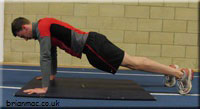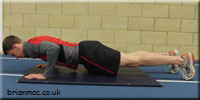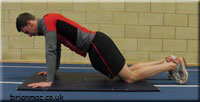

Press Up Test
Testing and measurement are the means of collecting information upon which subsequent performance evaluations and decisions are made. In the analysis, we need to consider the factors influencing the results.
Objective
The Press Up test's objective is to assess the strength endurance of the athlete's upper body muscles.
Required Resources
To conduct this test, you will require:
- Non-slip surface
- Assistant
How to conduct the test
|
 Figure 1  Figure 2 |
Athletes with less relative strength in the upper body can use the modified press-up position to assess their upper body strength.
|
 Figure 3  Figure 4 |
How much weight are you pressing?
When you perform the full press-up (Fig 1), you lift approximately 75% of your body weight, and in the modified press-up position (Fig 3), you lift about 60% of your body weight.
Assessment
The following normative data is available for this test:
The following table, McArdle et al. (2000)[1], provides normative data for the full-body press-up for Men.
| Age | Excellent | Good | Average | Fair | Poor |
| 20 - 29 | >54 | 45 - 54 | 35 - 44 | 20 - 34 | <20 |
| 30 - 39 | >44 | 35 - 44 | 25 - 34 | 15 - 24 | <15 |
| 40 -49 | >39 | 30 - 39 | 20 - 29 | 12 - 19 | <12 |
| 50 - 59 | >34 | 25 - 34 | 15 - 24 | 8 - 14 | <8 |
| 60+ | >29 | 20 - 29 | 10 - 19 | 5 - 9 | <5 |
The following table, McArdle et al. (2000)[1], provides normative data for the modified Press-Ups for Women.
| Age | Excellent | Good | Average | Fair | Poor |
| 20 - 29 | >48 | 34 - 38 | 17 - 33 | 6 - 16 | <6 |
| 30 - 39 | >39 | 25 - 39 | 12 - 24 | 4 - 11 | <4 |
| 40 -49 | >34 | 20 - 34 | 8 - 19 | 3 - 7 | <3 |
| 50 - 59 | >29 | 15 - 29 | 6 - 14 | 2 - 5 | <2 |
| 60+ | >19 | 5 - 19 | 3 - 4 | 1- 2 | <1 |
The following table, adapted from Golding et al. (1986)[2], provides normative data for the Press-Ups for Men.
| Age | Excellent | Good | Above Average |
Average | Below Average |
Poor |
| 17 - 19 | >56 | 47-56 | 35-46 | 19-34 | 11-18 | <11 |
| 20 - 29 | >47 | 39-47 | 30-38 | 17-29 | 10-16 | <10 |
| 30 - 39 | >41 | 34-41 | 25-33 | 13-24 | 8-12 | <8 |
| 40 -49 | >34 | 28-34 | 21-27 | 11-20 | 6-10 | <6 |
| 50 - 59 | >31 | 25-31 | 18-24 | 9-17 | 5-8 | <5 |
| 60 - 65 | >30 | 24-30 | 17-23 | 6-16 | 3-5 | <3 |
The following table, adapted from Golding et al. (1986)[2], provides normative data for the Press-Ups for Women.
| Age | Excellent | Good | Above Average |
Average | Below Average |
Poor |
| 17 - 19 | >35 | 27-35 | 21-26 | 11-20 | 6-10 | <6 |
| 20 - 29 | >36 | 30-36 | 23-29 | 12-22 | 7-11 | <7 |
| 30 - 39 | >37 | 30-37 | 22-29 | 10-21 | 5-9 | <5 |
| 40 -49 | >31 | 25-31 | 18-24 | 8-17 | 4-7 | <4 |
| 50 - 59 | >25 | 21-25 | 15-20 | 7-14 | 3-6 | <3 |
| 60 - 65 | >23 | 19-23 | 13-18 | 5-12 | 2-4 | <2 |
Analysis
Analysis of the test result compares it with the athlete's previous results for this test. It is expected that the analysis would indicate an improvement in the athlete's upper body strength endurance with appropriate training between each test.
Target Group
This test is suitable for active individuals but not for those where the test would be contraindicated.
Reliability
Test reliability refers to how a test is consistent and stable in measuring its intended measure. Reliability will depend upon how strictly the test is conducted and the individual's level of motivation to perform the test. The following link provides various factors influencing the results and test reliability.
Validity
Test validity refers to the degree to which the test measures what it claims to measure and the extent to which inferences, conclusions, and decisions based on test scores are appropriate and meaningful. This test provides a means to monitor training on the athlete's physical development.
Advantages
- No equipment is required.
- Simple to set up and conduct.
- The athlete can administer the test.
- Can be conducted almost anywhere.
Disadvantages
- An assistant is required to administer the test.
References
- McARDLE, W.D. et al. (2000) Training muscles to become stronger. In: McARDLE, W.D. et al., 2nd ed. Essentials of Exercise Physiology, USA: Lippincott Williams and Wilkins, p. 418
- GOLDING, L.A. et al. (1986) Y's way to physical fitness: the complete guide to fitness testing and instruction. 3rd ed, USA: Human Kinetics
Page Reference
If you quote information from this page in your work, then the reference for this page is:
- MACKENZIE, B. (2001) Press Up Test [WWW] Available from: https://www.brianmac.co.uk/pressuptst.htm [Accessed